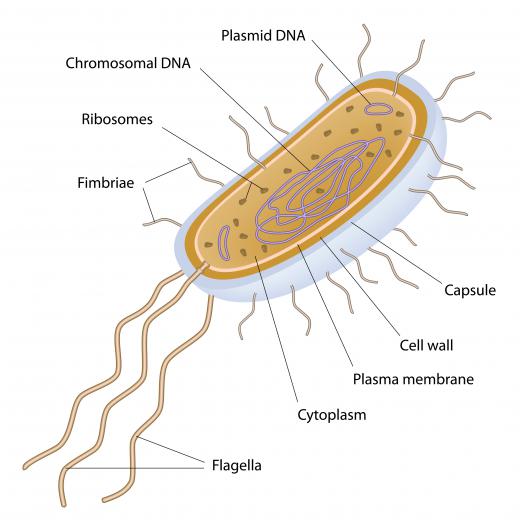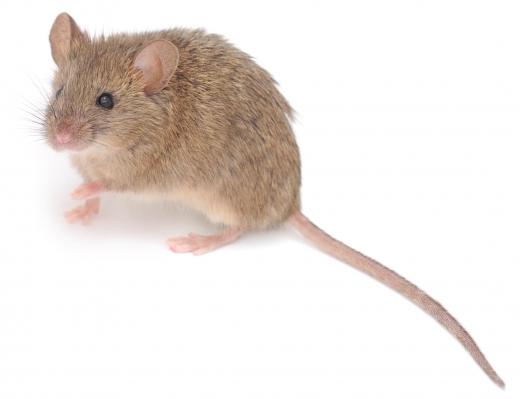What is Spirillum?
Spirillum is a type of bacterium that moves in a characteristic spiral, or corkscrew-like, fashion. It typically lives as individual cells, instead of being associated in clusters or chains. There is also a genus of gram-negative bacteria known as Spirillum, most members of which live in water with a large amount of organic matter, such as stagnant pools. A notable exception is Spirillum minus (S. minus), which is one of the two types of bacteria that can cause rat-bite fever.
Most types of bacteria possess flagella, or whip-like appendages, that help them to move through solutions. Bacteria from this genus have unusual types of flagella. It was originally thought that these bacteria had an individual flagellum on each end of their cells, but it is now known that they have a cluster on each end, composed of about 75 individual appendages. It is the motion of these that causes the organisms to move in their characteristic corkscrew fashion.

Spirillum volutans has been studied a great deal, since it is one of the largest species of bacteria. It was observed by early microscopists and identified in 1832. The name of this organism comes from from carbohydrate storage granules inside the organism, known as volutin.
It can be difficult to cultivate these bacteria, and S. volutans could not be grown in pure culture until recently. It turns out that the organism requires small amounts of oxygen but is poisoned by ambient concentrations. When there were contaminating organisms in the cultures, they used up enough of the oxygen that S. volutans could grow, but when it was in pure culture, however, it was unable to grow with the greater concentrations of oxygen. Once this requirement was understood, researchers were able to grow this bacterium in pure culture.

The Spirillaceae family is closely related to the family that includes Spirochaetes. This family of bacteria includes a number of human pathogens, including the bacteria that cause Lyme disease and syphilis. These organisms are also spirilla, and move in a corkscrew manner. They differ from the Spirillaceae in having specialized structures instead of flagella, and having an outer sheath.

One species of the genus, S. minus, is a human pathogen. It is one of the causal agents of rat-bite fever, although this form of the disease is found less frequently than another bacterial form. It is primarily a problem in Asia, being known as sodoku in Japan. This disease is typically contracted from the bites of rats, mice, and other rodents, or through exposure to the urine or secretions of an animal that has been infected.
AS FEATURED ON:
AS FEATURED ON:













Discussion Comments
What is that bacteria in the picture called?
@umbra21: I agree, modern medicine is incredible! However, 25 percent of it comes from the Amazon rainforest so if we keep deforesting there, we could get majorly ill, not that we wouldn't anyway when we run out of enough oxygen because there are no trees to turn our CO2 into O2.
Why don't spirillum exist in chain arrangements?
@irontoenail - Well, it's mostly common in countries where the symptoms are quite well known, like Japan, so hopefully people who experience them will know to go to the hospital quickly. Although apparently in Japan there is some danger of being exposed to it at the hospital, just because it is fairly common.
It's a bacteria though, so it responds to antibiotics, thank goodness.
Honestly, I don't think modern people really appreciate how incredible it is that we have medicine that will kill bacteria for us at a whim. Once people would have had to live with this horrible disease and just hope it wouldn't kill them. Now they just have to get to the doctor and hey presto, it's gone.
I think there's a bit of stigma surrounding rat bite fever, simply because of the implications of how you got it. I mean, the name is inflammatory enough, but when you factor in that it can also be caused by exposure to the spirillum bacteria through rat leavings, that makes it even worse.
But the truth is that this disease isn't always caused by that bacteria and that it isn't always transmitted through rodents either. It can be transmitted through cats or dogs who have been exposed to it, or through other household pets like gerbils and hamsters.
It can be very dangerous though, so if there is any chance that you might have contracted it, and in particular if you've been bitten by anything recently and start getting a rash and fever then you should contact a doctor immediately.
Post your comments